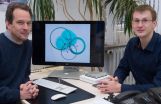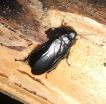Microplastics in the ocean: Biologists study effects on marine animals
2014-12-19
(Press-News.org) Bremerhaven/Germany, 18 December 2014. Ingestion of microplastic particles does not mechanically affect marine isopods. This was the result of a study by biologists at the North Sea Office of the Alfred Wegener Institute, Helmholtz Centre for Polar and Marine Research (AWI) that was published recently in the journal Environmental Science and Technology. The study marks the launch of a series of investigations aimed at forming a risk matrix on the sensitivity of different marine species to microplastic pollution.
Uptake of large plastic items by birds and fish may cause blockage of the gastrointestinal tract and severe starvation of the animals. "We were wondering whether small plastic particles have a comparable effect on smaller animals," says Dr. Lars Gutow from AWI's North Sea Office. "Only very limited research has been done on the effects of microplastics on living beings. Accordingly, there is great uncertainty about the implications for marine animals," the biologist explains the motivation for the study.
Lars Gutow and his colleagues selected the isopod Idotea emarginata as their model organism for an initial case study. In feeding experiments the researchers offered the isopods artificial algal food supplemented with plastic particles. The food contained three different kinds of microplastics in varying concentrations. They used industrially produced polystyrene particles with a diameter of ten micrometers as well as self-made fragments and fibres made of polyethylene and polyacryl, respectively.
The researchers studied the fate of the different materials under a light microscope, with the help of a fluorescence microscope, and with an electron microscope. They were able to trace the path of the microplastic particles through the isopods and determine the concentrations of the particles in different sections of the digestive system. The study showed that the concentration of microplastics in the faecal material of the isopods was as high as in the food. The scientists found small amounts of microplastics both in the stomach and in the gut of the animals. However, they did not detect any microparticles in the digestive glands. "The isopods ingested and excreted the artificial food with the microplastic particles without absorbing or accumulating the particles," Gutow summarises the results. Thus, plastic particles in the specific size range studied do not represent a direct mechanical risk for isopods and probably not for other crustaceans either. "In the case of Idotea emarginata, the microplastic particles did not enter the digestive gland, which is the principle organ in crustaceans where digestion and resorption of nutrients takes place," states the biologist from AWI's North Sea Office.
In a long-term experiment the scientists could also show that isopods did not display any long-term effects even after feeding on microplastic enriched food for six to seven weeks. Fitness parameters such as survival rate and growth did not differ between animals that were fed with and without microplastics, respectively. In an earlier study, however, AWI biologist Prof. Dr. Angela Köhler demonstrated that mussels show inflammatory reactions if they take up and absorb high concentrations of microplastic in an experiment. This clearly shows that different animal species react differently to microplastics. "In contrast to filter feeding mussels, isopods of the genus Idotea probably take up more frequently indigestible particles with their food in their natural habitat and may, thus, have adapted accordingly," elucidates Gutow.
But the biologists are not only interested in the feeding type: "We want to study systematically how the life style, habitat, physiology and anatomy of different marine organisms influence the uptake and utilisation of microplastic particles in order to come up with a risk matrix for diverse types of organisms," says Lars Gutow. "Therefore, it will be necessary to also study the possible chemical (toxic) and biochemical effects in addition to the physical effects that we looked at," he outlines future tasks.
INFORMATION:
Original Studies:
Julia Hämer, Lars Gutow, Angela Köhler and Reinhard Saborowski, Environmental Science and Technology (2014): Fate of Microplastics in the Marine Isopod Idotea emarginata (DOI: 10.1021/es501385y)
Nadia von Moos, Patricia Burkhardt-Holm and Angela Köhler, Environmental Science and Technology (2012): Uptake and Effects of Microplastics on Cells and Tissue of the Blue Mussel Mytilus edulis L. after an Experimental Exposure (DOI: 10.1021/ es5302332w)
ELSE PRESS RELEASES FROM THIS DATE:
2014-12-19
In a recent study from Lund University in Sweden, researchers have used new technology to study extremely fast processes in solar cells. The research results form a concrete step towards more efficient solar cells.
The upper limit for the efficiency of normal solar cells is around 33 per cent. However, researchers now see a possibility to raise that limit to over 40 per cent, thereby significantly improving the potential of this energy source.
The experiments in the present study involved 'juggling' on quantum level with photons, i.e. light particles, and electrons. ...
2014-12-19
In everyday life, the global positioning system (GPS) can be employed to reliably determine the momentary location of one en route to the desired destination. Scientists from the Institute of Physical and Theoretical Chemistry of the University of Bonn have now developed a molecular "GPS" with which the whereabouts of metal ions in enzymes can be reliably determined. Such ions play important roles in all corners of metabolism and synthesis for biological products. The "molecular GPS" is now being featured in the journal Angewandte Chemie.
There would be no life on our ...
2014-12-19
Bethesda, MD (Dec. 19, 2014) -- A new formulation of oral budesonide suspension, a steroid-based treatment, is safe and effective in treating pediatric patients with eosinophilic esophagitis (EoE), according to a new study in Clinical Gastroenterology and Hepatology, the official clinical practice journal of the American Gastroenterological Association. Eosinophilic esophagitis is a chronic immune system disease caused by a buildup of white blood cells in the lining of the esophagus. This build up, which is a reaction to food, allergens or acid reflux, can inflame or injure ...
2014-12-19
The changes can be measured, but their reasons were unknown. For several decades, scientists have carefully observed that the oxygen minimum zones (OMZ) in the tropical oceans are expanding. These zones are a paradise for some specially adapted microorganisms, but for all larger marine organisms such as fish and marine mammals they are uninhabitable. Thus, their expansion has already narrowed down the habitat of some fish species.
Marine scientists from the GEOMAR Helmholtz Centre for Ocean Research Kiel and the Kiel Collaborative Research Centre (Sonderforschungsbereich, ...
2014-12-19
PITTSBURGH--University of Pittsburgh researchers have shared their findings from three studies related to shale gas in a recent special issue of the journal Energy Technology, edited by Götz Veser, the Nickolas A. DeCecco Professor of Chemical and Petroleum Engineering in Pitt's Swanson School of Engineering.
In the special issue focusing on shale gas, Pitt faculty authors look at "smart wells" that use wireless communication, wastewater management, and information gaps between legislators, regulators, industry representatives, researchers, and the public on the ...
2014-12-19
Scientists from the Southwest University, Chongqing, China have found a new species and a new subspecies of cockroach. What makes these creepy crawlies distinctive from the cockroaches most of us know is that they don't infest human houses, on the contrary they prefer to live a hermit life drilling logs, hidden away from human eyes. The study was published in the open access journal ZooKeys.
Out of around 4,600 species worldwide, only 30 are the cockroaches associated with human habitats that gives the bad fame of these creatures. The representatives of the genus Panesthia, ...
2014-12-19
Most parents are not surprised by the irregularity of a newborn infant's sleep patterns, but by six months or so many parents wonder if something is wrong with their baby or their sleeping arrangements if the baby is not sleeping through the night. Healthcare providers, specifically nurse practitioners, can help parents understand what "normal" sleep patterns are for their child, according to researchers.
"Nurse practitioners are at the frontline of healthcare," said Robin Yaure, senior instructor of human development and family studies, Penn State Mont Alto. "They are ...
2014-12-19
Jacksonville, FL (December 19, 2014) - Investigators have found that young children with type 1 diabetes (T1D) have slower brain growth compared to children without diabetes. A new study, published in the December issue of Diabetes, now available ahead of print, suggests that continued exposure to hyperglycemia, or high blood sugars, may be detrimental to the developing brain. The research was supported by the National Institutes of Health (NIH).
"Our results show the potential vulnerability of young developing brains to abnormally elevated glucose levels, even when ...
2014-12-19
(MEMPHIS, Tenn. - DECEMBER 18, 2014) A study led by St. Jude Children's Research Hospital scientists has identified the population of white blood cells that tumors use to enhance growth and suppress the disease-fighting immune system. The results, which appear in the December 18 edition of the scientific journal Immunity, mark a turning point in cancer immunology and provide the foundation for developing more effective immunotherapies.
For years, researchers have known that a diverse group of white blood cells called myeloid-derived suppressor cells (MDSC) are more abundant ...
2014-12-19
In a previous randomized controlled trial, Stanford University researchers developed two curricula for Girl Scouts to use energy more efficiently: one on energy use at home, and the other in transportation and food. Both courses were effective for girls in the short term, and the home energy course was effective for girls in the long term and for parents in the short term.
Subsequently, the Northern California Girl Scouts began disseminating the programs via manuals and reusable materials, but that method of disseminating the programs has not lead to widespread use.
On ...
LAST 30 PRESS RELEASES:
[Press-News.org] Microplastics in the ocean: Biologists study effects on marine animals

